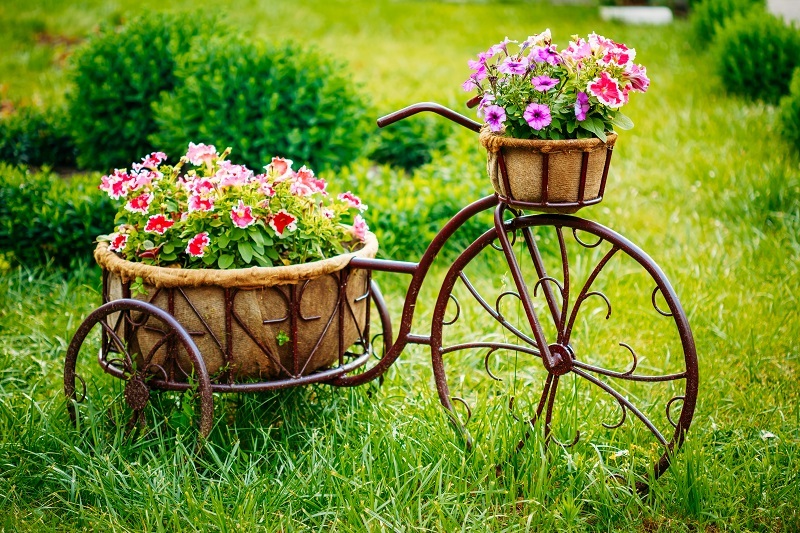Achieve Garden Glory with Proper Hydrangea Care
Posted on 21/08/2025
Achieve Garden Glory with Proper Hydrangea Care
Hydrangeas are among the most beloved flowering shrubs in gardens around the world. Their luxurious blooms, vibrant colors, and lush foliage can turn any outdoor space into a dreamy haven. However, unlocking the full potential of these plants requires proper hydrangea care. This comprehensive guide will unveil expert tips and techniques for achieving garden glory with hydrangeas, ensuring your bushes become the envy of your neighborhood.
Understanding Hydrangeas: Types and Features
Before diving into care routines, it is crucial to recognize the various hydrangea varieties. Each requires unique attention, and knowing your type will help meet their specific needs.
Main Types of Hydrangeas
- Hydrangea macrophylla (Bigleaf Hydrangea): Famous for mophead and lacecap blooms, these are popular due to their color-changing abilities.
- Hydrangea paniculata (Panicled Hydrangea): Known for conical blooms and exceptional hardiness.
- Hydrangea arborescens (Smooth Hydrangea): Produces large white blooms; 'Annabelle' is the most well-known variety.
- Hydrangea quercifolia (Oakleaf Hydrangea): Recognizable by oak-shaped leaves and elongated flower clusters.
- Hydrangea petiolaris (Climbing Hydrangea): A unique vining variety suited for walls and trellises.
Pro Tip: Identify your hydrangea type by examining the flower shape, leaf texture, and growth habit. This helps tailor hydrangea care routines for optimal results.

Planting Hydrangeas for Lasting Garden Glory
Site Selection and Preparation
Location is pivotal. Hydrangeas thrive in areas with morning sun and afternoon shade. Sheltered spots protect from harsh winds and hot afternoon rays, preventing leaf scorch and dehydration.
- Soil Requirements: Hydrangeas prefer rich, well-draining soil with abundant organic matter. Aim for a pH between 5.5 and 6.5 for most varieties.
- Space: Allow ample room for air circulation, crucial for minimizing disease.
- Planting Depth: Dig holes as deep as the root ball and twice as wide to encourage root growth.
Planting Steps for New Hydrangeas
- Water your hydrangea container thoroughly before planting.
- Remove the plant, loosen roots gently, and set it in the prepared hole.
- Backfill with enriched soil and press firmly to eliminate air gaps.
- Water deeply and apply a layer of mulch to conserve moisture and control weeds.
Expert Advice: Autumn and early spring are the best seasons for planting hydrangeas, giving roots time to establish before hot weather hits.
Hydrangea Watering Secrets: Achieving Lush Blooms
Perfect Watering Practices
Correct watering is at the heart of hydrangea care. Too little, and leaves wilt; too much, and roots rot.
- Hydrangeas need consistently moist soil, especially during their first two years and in periods of drought.
- Soak the soil to a depth of 6-8 inches rather than sprinkling leaves, which can promote fungal disease.
- Water early in the morning to reduce evaporation and allow foliage to dry before evening.
Tip: Hydrangeas "signal" when thirsty - leaves wilt and become matte. A prompt drink will revive them quickly!
Feed Your Blossoms: Essential Fertilization for Hydrangeas
Choosing the Right Fertilizer
Fertilization boosts color, vigor, and lushness. Use a balanced slow-release fertilizer in early spring for most varieties. However, hydrangeas are not heavy feeders; over-fertilizing leads to leafy growth with fewer blooms.
- For blue mopheads, add a phosphorus-light, acidifying fertilizer to support blue hues.
- For pink and red hydrangeas, use a balanced fertilizer and lime the soil to raise pH.
- Panicle and smooth hydrangeas thrive with a simple dose of compost or a 10-10-10 granular fertilizer.
Organic Boost:
Annually apply 2-3 inches of compost or well-rotted manure to maintain soil fertility naturally. This also improves drainage and supports beneficial soil microbes.
Pruning Hydrangeas for Structure and Abundant Blooms
When and How to Prune
Pruning hydrangeas can be confusing because different types bloom on old wood, new wood, or both. Understanding your plant's flowering habits is key to garden glory:
- Macrophylla (bigleaf) and Quercifolia (oakleaf): Bloom on old wood. Prune just after flowering, removing spent blooms and dead wood. Avoid hard pruning in spring or fall, as it removes next season's flower buds.
- Paniculata and Arborescens: Bloom on new wood. Prune in late winter or early spring before new growth emerges. Cut back stems by one-third to encourage large blooms and a tidy shape.
- Pruning climbing hydrangeas: Trim only to shape and remove dead branches, preferably after flowering.
Remember: Maintaining the right pruning schedule maximizes flower production and keeps shrubs healthy.
Mastering Hydrangea Color: Soil pH and Flower Hues
Color-Change Magic
One of the unique joys of growing hydrangeas--especially the bigleaf types--is the ability to change flower color by adjusting soil pH.
- Blue Flowers: Acidic soil (pH 5.2-5.5). Add aluminum sulfate or peat moss to lower pH.
- Pink Flowers: Alkaline soil (pH 6.0-6.2). Add ground lime to raise pH levels.
- White hydrangeas usually do not change color with soil chemistry.
Test Your Soil annually using a home pH kit. Apply additives slowly and monitor plant responses over several months for the best results.
Pest and Disease Control for Hydrangeas
Common Issues and Solutions
Even with attentive hydrangea maintenance, pests and diseases may make an appearance. Vigilance is essential for ongoing garden glory.
- Pests: Aphids, spider mites, and slugs occasionally target hydrangeas. Hose off aphids, introduce ladybugs, or use insecticidal soap if infestations are severe. Copper tape and iron phosphate pellets deter slugs.
- Diseases: Powdery mildew, leaf spots, and root rot are common threats. Promote air circulation, avoid overhead watering, and remove infected leaves promptly.
- Preventative care: Sharpen and disinfect pruning tools to avoid disease spread, and mulch appropriately to keep foliage dry.
Healthy hydrangeas resist problems better. A strong, well-fertilized, and properly watered plant stands up to pests and diseases more effectively.
Hydrangea Winter Care: Surviving the Cold
Protecting Your Plants
Winter can be tough on hydrangeas, especially in northern climates. Proper preparation ensures enthusiastic spring growth and abundant blooms later in the year.
- Cease fertilization and pruning in late summer to allow stems to harden.
- Add 3-4 inches of mulch or shredded leaves around the base for root protection.
- Wrap stems of sensitive varieties with burlap if severe cold is forecast.
- For container hydrangeas, move pots to sheltered locations or insulate with bubble wrap and mulch.
Hydrangea Landscaping Ideas for a Glorious Garden
Stunning Hydrangea Combinations
Hydrangeas shine both as specimen plants and as part of lush mixed borders. Use them in:
- Formal beds with boxwood, roses, or azaleas
- Woodland gardens paired with ferns, hostas, and astilbes
- Cottage gardens alongside lavender, echinacea, and salvia
- Foundation plantings to soften home outlines
- Privacy screens by mass planting panicle or smooth hydrangeas
Creative tip: Underplant hydrangeas with spring bulbs like daffodils or tulips for months of sequential bloom and color interest.

Frequently Asked Questions: Hydrangea Care and Cultivation
How much sunlight do hydrangeas need for best blooms?
Most hydrangeas prosper in partial sun: morning light and dappled afternoon shade are ideal. Panicle and smooth varieties tolerate more sunlight than bigleaf types.
Why aren't my hydrangeas blooming?
- Improper pruning--cutting off flower buds by mistake
- Too much nitrogen fertilizer resulting in leaf, not flower, growth
- Late frost or winter damage to emerging buds
- Too little sunlight or severe drought
How long do hydrangea flowers last?
Hydrangea blooms persist from late spring through summer and, in some varieties, well into fall. Dried flowerheads can be left for winter interest or cut for indoor arrangements.
Conclusion: Achieving Garden Glory with Healthy Hydrangeas
Caring for hydrangeas may take a little effort, but the rewards are spectacular. By choosing the right type, preparing ideal soil, providing consistent watering and fertilization, pruning wisely, and protecting plants from environmental stress, you'll enjoy vigorous growth and stunning blooms season after season.
Ready to transform your garden into a hydrangea showcase? Follow these essential hydrangea care tips, and every neighbor and visitor will marvel at your glorious displays!
- Remember: Observe your plants and adapt care as needed--they'll guide you toward their happiest, healthiest selves.
- Experiment with soil and locations to discover what your hydrangeas love most.
- Share your success, and spread garden glory throughout your community.
Garden glory awaits - start your hydrangea journey today!
Latest Posts
Achieve Garden Glory with Proper Hydrangea Care
Enrich your knowledge with 7 hidden tulip facts
Revive and Sustain Poinsettias for Longer Enjoyment
Minimal Effort, Maximum Impact: Office Plant Selection
Gateway to Perpetual Blooms: 12 Long-Lasting Flower Champions





